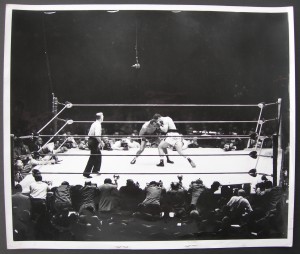Not to Be Forgotten: Old Time Fighters
 By Ian “The Boxing Historian” Murphy
By Ian “The Boxing Historian” Murphy
When the majority of people try to rate and compare top all-time fighters, the old-timers tend to be forgotten. This is partially due to a greater passage of time, but also because casual boxing fans do not have the same level of reverence (and often knowledge) for it’s history in the same way other sports do. Many modern (and even not so casual) fans know the current stars, and maybe a few from the past 30 to 40 years like Muhammad Ali, Ray Leonard, and Mike Tyson. Beyond a certain point, (lets use 1980 for example) history gets little foggy for a lot of fight fans, especially younger ones. The great champions of even the 1960s and 1970s become lost, and their memories are kept alive by either much older fans, or a small, yet dedicated group of younger ones. Go back any further than that, and they are practically forgotten. This is a shame, as knowing boxing’s history can help you appreciate (or rightly criticize) the sport in its current incarnation. It allows you to have a better understanding of the caliber of the fighters you are observing.
In contrast to boxing, America’s other top historical pastime, Baseball, is a sport that is in constant contact with it’s past, and the powers that run it bring special attention to historical milestones and accomplishments. Yes, you might hear a Boxing commentator or columnist throw around names like Roberto Duran when referencing current Lightweights or Sugar Ray Robinson when talking about recent pound for pound king Floyd Mayweather JR., but this is increasingly rare. Sadly, many fans are completely ignorant as to how great the old-timers truly were. Does anyone even realize how incredibly brilliant Benny Leonard was as a fighter? Baseball fans are fully aware of the legends of yesteryear. If you mentioned “Murderers Row” to even a casual baseball fan in, say, 1960, instantly an image of the 1927 Yankees starring Babe Ruth and Lou Gehrig would come to mind. Even now, more than 85 years later, a big baseball fan would at least have heard of that term and the team associated with it.
Baseball fans on the whole know what happened in even its very distant past, and the sport has the hallowed records and legends to prove it. If you mention Mickey Mantle, Bob Feller, Ty Cobb and Henry Aaron’s names in a discussion with fans of all ages, those names at a bare minimum will be recognized. Some fans will be a little more well versed than others, but most will know that Mantle was mythic in his physical abilities, that even in the 1930s Feller threw with serious heat, and that Cobb was a psychotic but brilliant player. They will appreciate that Henry Aaron’s discipline and consistency (at a time where there was incredible racial pressure and upheaval) were mind boggling. Baseball constantly marks historical achievements. If we take a comparable group of boxers from the same eras like Ezzard Charles, Henry Armstrong, Carlos Monzon and Billy Conn, you’d be hard pressed to find anyone who know too much about them, or even knew who they were. Even if they did know who those legends were, most fans would assume they were not as good because, you know, “newer is always better”. This is a sad state of affairs, and the sport of boxing should try harder to preserve their memories and keep them in the spotlight.
Part of what makes this difficult is that while boxing has retained some degree of popularity (PPV numbers are healthy to say the least), it does not have the same level of presence in our Pop Culture as it did in the past. When boxing was at the peak of its popularity (appx. 1920 to 1960), your top boxers were household names and being the Heavyweight Champion (there was only one!) was the biggest prize in sports. Boxing was interwoven into the fabric of both our national identity as Americans, and championship matches (especially Heavyweight) were, along with the Kentucky Derby and the World Series, the sporting events of the year. If you had a billboard picturing recognized Heavyweight Champion Wladimir Klitschko on a street in a major city, it is unlikely that most people would even know who he is. Part of this is because he isn’t American, but more so because boxing is not as popular as it once was.
As much as we all love the Sweet Science, the awful mismatches and the multitude of “world” champions are tarnishing this great sport. This hurts its credibility. Some knowledge of the sport’s history can put things into proper perspective. For example, people today talk about Manny Pacquiao being an “8 Division Champion”. Yes, technically that is true, but how many of those divisions were created just for the purpose of more title fights and sanctioning fees? Had the original 8 divisions still been in place, Manny might have been a 3 division champion. This is still a great accomplishment, but is it more impressive than a 133lb Henry Armstrong holding the Featherweight, Lightweight, and Welterweight Championships simultaneously in 1938? I think not. There is over a 20lbs difference in weight from FW to WW! This is akin to a Super-Featherweight bombing out the Welterweight champion. However, so many boxing fans have no clue who “Homicide Hank” was. This is a pity, as the man (and also other greats like Tommy Loughran, Sandy Saddler, and Emile Griffith to name a few) deserves much more recognition and praise.
[si-contact-form form=’2′]

